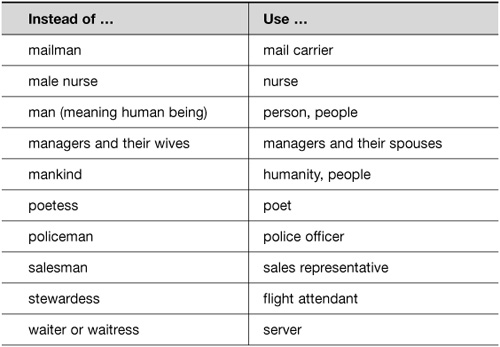U
UNBIASED LANGUAGE
Most gender problems can be avoided without the use of he/she, he or she, him or her, or him/her constructions. Plural pronouns such as they can be very helpful in this regard.
An occasional he or she is okay, but after a while using the same pronoun becomes distracting.
When a singular pronoun is necessary, use either he or she consistently to avoid confusion.
Sexist Language
A variety of words and phrases make demeaning assumptions about gender-related roles. Substitutes should be reasonable and appropriate. Try not to look as though you are avoiding sexist language.
Table 2.32 contains a list of words to avoid and their alternatives.
Table 2.32 Biased Words and Their Alternatives

UNCOUNTABLE NOUN
Nouns with no plural form are called uncountable nouns or mass nouns.
Example: air, water, furniture, music, art, love, luggage, sugar, electricity, money, currency, information.
Uncountable nouns are paired with a singular verb.
Example: This water is very refreshing.
Indefinite articles a and an are not used with uncountable nouns. Some, any, a little, and much are used with uncountable nouns.
Example: May I have a little water.
UNDERLINING
Underlining is used the same way italics are used, to designate titles of publications, although italics are preferred.
Underlining is also used to designate hyperlinks in a document such as email addresses or Web addresses.
UNDERSTATEMENT
An understatement is a figure of speech where a lesser expression is used than might be expected, usually for humorous or literary effect.
Example: The lean-to was hardly well-appointed.
UNTIL, BY
See By, Until.
UPLOAD, DOWNLOAD
UPPERCASE
Uppercase is an adjective meaning capital letters. Upper case (two words) is the related noun. Never use all uppercase letters for emphasis in emails.
For computer-related procedures, keyboard key names should be in upper case.
Example: Press the ENTER key.
Use upper case for acronyms.
Example: NASA, FIFO.
URL
URL is an acronym for uniform resource locator. A URL is an address for a Web site on the Internet or an intranet.
When writing about URLs in technical documents, use the indefinite article a instead of an.
Example: Each Web site has a URL.
A URL includes an Internet protocol name, a domain name, and other information such as file names, directories, and port names. Internet protocol begins with http:// and each of the elements after the Internet protocol is separated by a slash.
Example: http://www.videologies.co.
Most of the time, a URL can be typed in all lower case.
When including a Web address in a business document, it is not necessary to include the Internet protocol (http://).
Example: www.videologies.co.
When referring to an entire Web site, you can drop the www at the beginning of the address.
Example: I do a lot of shopping on Amazon.com.
To include a URL as a hyperlink in a document, set the URL off on its own line of text.
U.S.
U.S. is an abbreviation for United States. It is appropriate to use U.S. as an abbreviation when it acts as an adjective.
Example: They expect to be paid in U.S. dollars.
Do not use the U.S. abbreviation when it acts as a noun.
Example: They wanted to visit the United States.
USED TO
Used to is a phrase that refers to something that happened often in the past but no longer occurs.
Example: I used to ride my bike every day.
Used to also refers to something that was true but is no longer.
Example: I used to live in Texas.
Use to without the d is incorrect for this purpose.
UTTERANCE
An utterance is one complete unit of spoken language. It can be something as short as one word, such as oh, to a complete sentence from one speaker in a dialogue.

